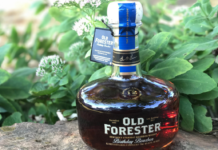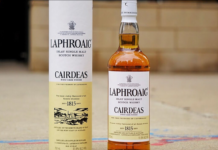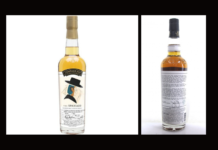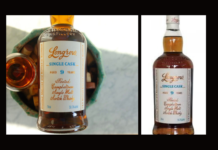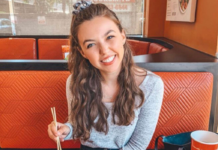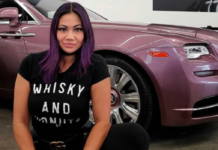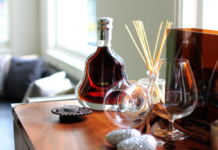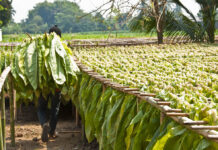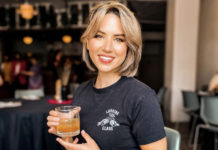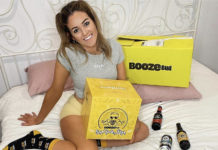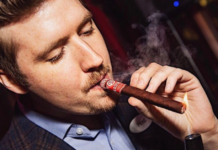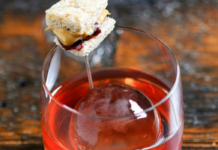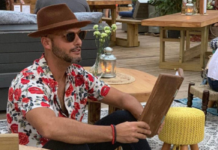Kings County Distillery is New York City’s oldest operating whiskey distillery, the first since prohibition. Founded in 2010, Kings County makes handmade moonshine, bourbon, and other whiskeys out of the 117-year-old Paymaster Building in the Brooklyn Navy Yard. They use New York grain and traditional distilling equipment to make distinctive spirits. We had the opportunity to speak with Ryan Ciuchta, the head blender at Kings County Distillery.
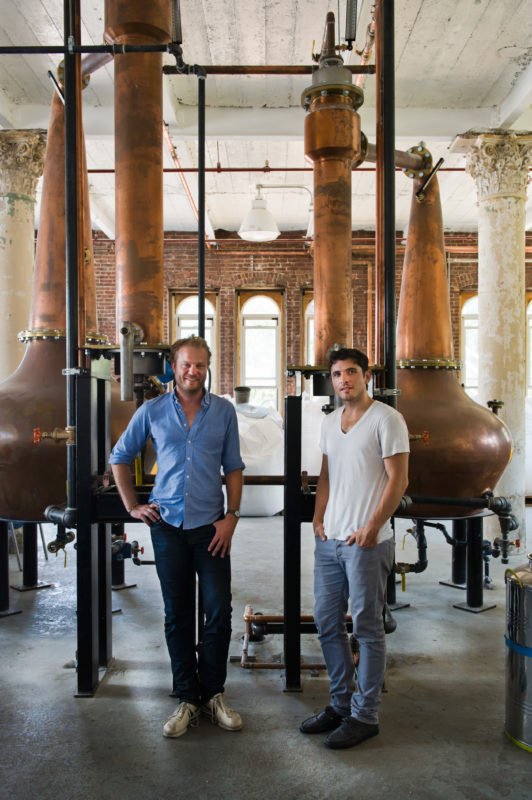 (Photo courtesy of Valery Rizzo – valeryrizzo.com)
(Photo courtesy of Valery Rizzo – valeryrizzo.com)
Ryan, can you tell us a bit about how you got started at Kings County Distillery?
R: Funny story actually. I attended a tour of the distillery in April of 2013 with two of my whiskey friends. Our tour guide happened to be my old boss and former Master Blender, Nicole Austin. I whispered to my friends that I was going to figure out some way of working with her to learn her craft. After the tour and tasting I asked her a few questions and signed up with my e-mail address for what I thought was a newsletter on a clipboard at the tasting room bar. Had I actually been paying attention I would have seen the header that said “Volunteer Sign-Up”.
Three days after the tour I got an e-mail from Brianna, our current head of visitor services (then volunteer tasting room manager), asking if I’d like to work on the bottling line that coming Saturday. I was incredibly stunned and honored. I thought that they must have been impressed with my questions and the chat I had with Nicole after the tour and wanted me to work for them. I gladly showed up that Saturday and had my first shift on the bottling line. I asked Brianna if I could come back the following week and help out as they needed going forward.
During my third week on the bottling line is when I finally found out that I had signed up as a volunteer and was not, in fact, as special as I thought I was. Very humbling indeed. I continued working on the bottling line on Saturdays for 6 months or so while simultaneously cozying up to Nicole to see if I could help her with pulling barrel samples or any other grunt work that involved the blending process. She accepted my inquiry, leading to us becoming closer as co-workers and friends. As the trust grew she agreed to let me sit in on a blend with her for batch 81 of our flagship bourbon. She was kind enough to take me under her wing thereafter as an apprentice blender and to let me manage all of the barrel inventory and sampling over the next 51 batches we did together.
Nicole left us in September of 2016 to head to the greener Irish pastures of Tullamore Dew. I am quite fortunate that our owners, Colin Spoelman and David Haskell, decided to trust me as her successor. They offered me a full time job to leave my publishing career and become the Head Blender and Production Manager of the distillery. From clueless volunteer to Head of Production and Blending in 3.5 years – a true Cinderella story!
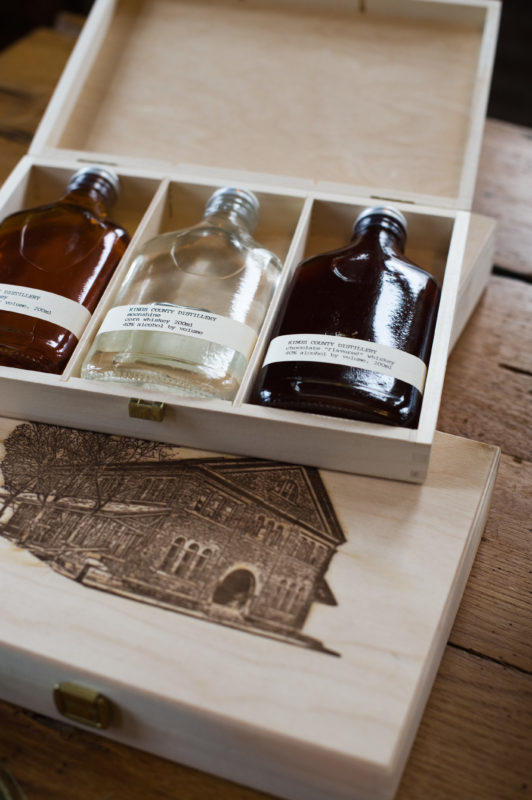
That’s quite an amazing story Ryan. When Kings County began distilling were they aiming for a certain style of whiskey or liquor?
R: We are, and plan to always be, whiskey distillers. Aside from a small batch of brandy that we distilled with a local wine partner in Brooklyn we have never used our still capacity for anything other than whiskey. Colin’s ethos was to produce only whiskey and to do it well, with all of our focus on a single distillate. He wanted to carve out our place in the craft arena and differentiate ourselves in the marketplace by making whiskey that wasn’t the same as the standard KY offerings. We have a high corn content whiskey without a flavor grain, such as wheat or rye. We operate mainly under a farm distillers license for our production.
Our moonshine and bourbon recipes contain predominately NY state corn with the remainder of the mashbill being Golden Promise malted barley from the UK. The high malt content means that we don’t have to rely on artificial enzymes during mashing. Using flavor retaining double pot distillation we are able to sell an unaged whiskey, highlighting the art of distilling clean, flavorful spirit even before it touches oak. I like to say that our whiskey is great off the still and is enhanced by the barrel rather than simply putting a more neutral white dog in and letting the barrel do all of the work. The craft of distilling is at the forefront here.
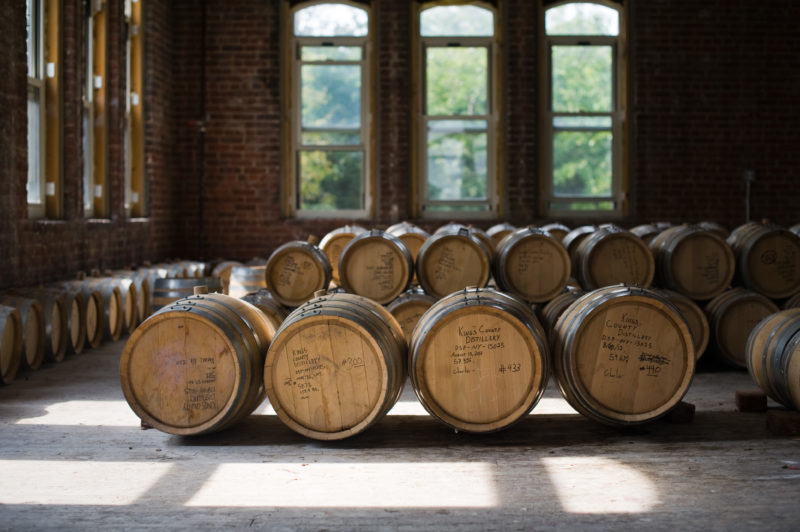 (Photo courtesy of Valery Rizzo – valeryrizzo.com)
(Photo courtesy of Valery Rizzo – valeryrizzo.com)
Could you please tell me a bit more about you guys, the founding team behind Kings County Distillery and why your team decided to set up a whisky distillery in Brooklyn, NY and not in Kentucky?
R: Colin, our founder, grew up in the western part of KY, the Appalachian part of the state, in the dry county of Harlan. Some assume that being from KY you have a family lineage in distilling. Colin did not, but he did have to rely on bootleggers to feed his teenage desires to drink. Being a dry county meant that these “bootleggers” would drive over the line to smuggle in Bud Light, Zima and 40s to sell to high school and college kids. These bootleggers, in turn, also had connection to moonshiners that were making backwoods corn whiskey.
After college, Colin moved to New York City and before long had to start fielding questions about whiskey due to his home state affiliation. He began researching whiskey and subsequently started bringing milk jugs of illicit moonshine back to NY after trips home to see family. New Yorkers, being the curious set that they are, were thrilled to try this intriguing spirit. This moonshine though was not good. It got him thinking about what makes a good unaged spirit. Vodka, gin, tequila, brandy and rum are all consumed in some way unaged, but in whiskey it was taboo.
He and his roommate, turned business partner, David Haskell began exploring what made a good unaged whiskey by home distilling, an unwise and illegal endeavor. As their batch’s flavor progressed they started to gain a market for their spirit through friends and parties they attended. Soon after the NY press picked up on their cult following and they soon had to take their operation legit before the Feds came knocking.
When the NY state liquor laws were changed in the late mid-late 2000s and the high cost of holding a distilling license fell to only a few hundred dollars, Colin and David applied for and received the first license to distill whiskey in the 5 boroughs of NYC since prohibition. This was in 2010. We have the fun distinction of being both old and young – The Oldest Whiskey Distillery in NYC… all of (close to) 7 years!
Many of our employees have been here for the majority of the time the business has been open. Most of our distillers have been here for 5+ years helping to give great consistency to our production process. There is a lot of loyalty and ownership within the company that has created a tight knit group. Many more of us started as volunteers and worked our way up to full or part time positions. Colin and David have been able to retain passionate people that care about the company and the products we produce.
Wow, must be amazing working with people who are truly passionate and love their craft. What would you say is the most rewarding part of your job?
R: When guests or others I meet out tell me how much they like our whiskey. I’ll often hear “I never liked whiskey until I had Kings County”. That makes it worth the long hours and physical labor to get our whiskey on the shelf. Knowing that people genuinely enjoy it and are rooting for us is inspiring daily. And my co-workers. We all appreciate what each other does to keep the business up and running. After 12 years in the corporate world, it’s refreshing to be back to basics with a tight crew that has a “whatever it takes” mentality.
Can you tell us whats a typical day like for you as a head blender and production manager ?
R: If there is one thing I learned very quickly it was that there is no typical day in a distillery/small business. My role encompasses maintaining our product integrity and consistency, developing new products, ensuring proper inventory levels, quality control, production reporting, forecasting, barrel management, bottling line efficiency and most fun of all sampling and blending our aged products. I have incredibly smart, creative and hard working colleagues that allow me the time I need to focus on product quality by doing their jobs efficiently everyday. We are a small operation and all of us wear meany hats to ensure that it gets done – no task is beneath any of us. I’m just as likely to be sweeping the stairs as I am giving a tour, proofing tanks or pulling barrel samples. That’s the best part of the job – no day is the same and I still get my hands dirty!
So basically you are a jack of all trades. Kings County carries a Peated bourbon, tell us a little about what it’s like to use peat in whiskey and how do you feel it influences the bourbon’s taste?
R: We like to call this product our happy accident. We ran out of our regular malt on one of our night distilling shifts. The mash cooker was already an hour into the process with 220 gallons of corn and water before our distiller realized he was out of Golden Promise malt. We had a few bags of our peated malt left over from a single malt we had been distilling so he decided to just use that instead. The spirit tasted great and Colin was intrigued by the concept of a peated bourbon. As far as we knew, no one else was doing it and it still met all of the legal requirements to be called bourbon.
Our current releases are using predominately corn with our barley content split between Golden Promise and peated malt. This imparts an earthy note to the finish with a lingering smoked malt flavor. It’s a subtle difference but one that we are proud of and hope to develop as a main stay of the product line. Over the last year we’ve adjusted the mashbill so that the full malt content is peated to see if the smokey characteristics become more prominent after barrel aging.
Ryan, tell us frankly, what is your distillery doing to stand out in the bourbon market?
R: I think the clearest answer to this is reflected in our packaging. We are more about what’s in the bottle than the fancy trimmings that are all to easy to get wrapped up in. And that sense of simplicity in the packaging is reflected in the distillery and those that run it. We all put a great amount of time and devotion into our respective duties to make a great product that we are proud of. As I mentioned before, we are about good, clean spirit off the still, flavorful aged batches and funky, creative alternative whiskies – be it infusions or unique grains.
On the more technical note, I think we have many areas that set us apart on the production side. We use all NY state grown corn in our mashbill, which in and of itself is unique without a flavor grain. Open air oak fermentation tanks, custom built Forsyths pot stills, barrel sizes ranging from 5-10-15-30-53 gallons for aging all give me great spirit to blend from. Every barrel that makes it into a batch of our whiskey is evaluated by me and my assistant, Stella. Nicole instituted our blending program and I think it’s a unique aspect of the business. We devote the time to making sure that our aged products maintain a consistency and quality level that we can be proud of – down to nosing each barrel sample and going through multiple barrel blends before we decide what is the best batch to put in our bottle.
Lastly, I would say that being a small producer fosters experimentation. Colin and David are very open to ideas for new products and are willing to give the distillers the resources to try something new. As the old comparison goes, its much easier to steer a speed boat that an aircraft carrier. Being small allows us the freedom to innovate without the hassles of huge logistical/production shifts. It’s one of the hallmarks of craft distilling and we are happy to be apart of the craft community that are producing some truly unique whiskies.
There are many craft distilleries who are experimenting with different cask finishes of their whiskey. Do you think one day you’ll end up making a Sherry Cask Finished Bourbon?
R: It’s not on the agenda as of the moment but I never say never. We actually have a wine cask finished bourbon that we sold out of our tasting room. This was a collaboration with a sommelier that Nicole had met at an industry event. She secured a 60 gallon ex-fortified Cab Frac cask for us. We did a young blend of bourbon, about 13 months out of 5 gallon barrels and finished it in the wine cask for about 8 weeks during the hot summer months. It turned out exceptionally well. I’ll love to experiment with other finishing techniques in the coming years.
Ryan, we’d like to ask about your personal favorites. What is your favorite dram at the moment?
R: My all-time favorite is W.L. Weller – whether it be the 12 yr, Antique 107 or Special Reserve. This was (and still would be if the price hadn’t skyrocketed) my everyday whiskey for years and I still love to enjoy a glass whenever I find it for a reasonable price. I tend to be a little seasonal with my whiskey drinking. Now that we are in the thick of winter I am drinking more scotch. Bunnahabhain 18 is a favorite as well as Laphroiag Triple Wood, Talisker 18 and Jura 10. I am an equal opportunity whiskey imbiber and drink different types and styles as my mood (and temperature) dictates.
We like equal opportunity whiskey imbiber’s, they are our kind of people. Ryan, do you believe in the phrase “Whiskey is the new Wine?”
R: That’s an interesting question that I’d never really thought about before. For as intensely committed as I am to whiskey, spirits and cocktails, I know very little about wine and beer outside of the basics. I think that there has probably always been a whiskey culture that has appreciated the nuances of the spirit, especially going back to the emergence of single malt scotches in the 80s.
I think the whiskey culture has benefited from and fed off of the wine world in how we review and analyze whiskey so in that sense it could be seen as the new wine. Wine and whiskey enthusiasts share the trait of looking for where the distinct flavors and differences come from in each bottle. Both are affected by their respective source material (grain/grape), water, yeast strains, fermentation, temperature, maturation, etc. In distillation we add still shape, speed of the run and cuts. The complexity and care that goes into both beverages certainly puts them on an even playing field now. I think wine is still flourishing but whiskey has come up to hold it’s own! The average whiskey enthusiast is much easier to find these days than in the past.
Is there anything else you’d like to share with our Tastethedram readers?
R: We are excited by our upcoming release of Bottled-in-Bond bourbon which gives us another link to the rich history of bourbon making. Produced to the same standards set forth in the Bottled-in-Bond Act of 1897, this is a 4 yr, 100 proof whiskey that was aged in 15 gallon barrels. It is the product of one distilling season and was produced, aged and bottled at our facilities, like all of our whiskey has been since opening. We have been laying down more whiskey over our almost 7 years of existence than we’ve been bottling which has put us in a position to have one of the largest stocks of craft whiskey in the country. It’s exciting to be able to finally be able to tap into these older barrels and be rewarded for our patience!
We’d love to have any readers of the blog come and visit us at the Brooklyn Navy Yard for a tour and tasting or to hang out at our Gatehouse bar for a cocktail.





